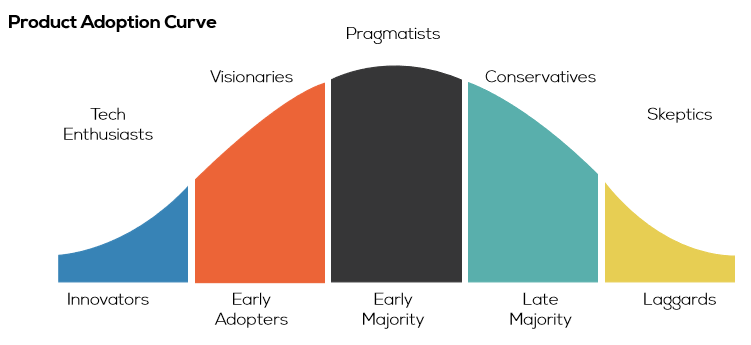is strategic marketing just a buzz word?
We don’t think so, but we understand why it is grossly misunderstood.
In the oil and gas industry, marketing is largely measured on the output of tangible mass communication items such as brochures, flyers, press releases, videos, webpages, events, etc. Rarely do senior executives ask marketing managers to demonstrate how their budget allocation and spend helped improve the company’s position.
We believe a marketing team’s goals should be a derivative of business objectives and fully aligned to help the organization achieve measurable results. Making the transition from tactical marketing to programmatic marketing can be challenging because it requires a shift in mindset, and extensive collaboration between Sales, Marketing and Product Management.
Proactively designing the customer journey is one of the cornerstones of strategic marketing as it keeps the business goal at the forefront, and requires several tactics working together in harmony. It also requires the ability to pivot quickly based on frequent review of Key Performance Indicators (KPIs). Data analytics, engagement planning, content generation and the ability to measure marketing ROI are a few of the components needed to develop marketing strategies.
Value Propositions in a Changing B2B Marketing Environment
Value proposition creation in the digital age is more important now than ever before. Changing your methodology and creating value propositions appropriate for the product lifecycle and your customer's buying journey requires a new set of tools.
WHAT HAPPENS When SALES, Marketing AND PRODUCT MANAGEMENT aren't aligned to meet the business requirements?
You will likely experience a colossal disconnect between what the Marketing team is promoting and where the investment of resources should have been allocated. We see this disconnect manifest itself often. Business units have a revenue target to meet which requires a demand generation or customer retention program, but the marketing effort is supporting general corporate brand awareness.
Strategic Marketing means looking at the customer from a holistic perspective and taking an integrated approach to define how best to serve and satisfy the customer’s needs so every interaction with the organization is favorable. This is not the job of Marketing alone, but rather requires Marketing to organize the information, goals and deliverables in a way that creates cross-functional ownership of the collective objective. Working together with Sales and Product Management, Marketing can implement the program in a measurable way so the company has the ability to test variables, optimize the program, and meet the business goals.
Journey-in-Action: Marketing ROI Dashboard
Learn More about strategic marketing by 25|25:
Video: Creating Value Propositions
Every Go-to-Market plan should have a series of value propositions that are tailored to the customer buying experience and the unique personas involved in the purchasing decision. In B2B complex sales these value propositions and supporting proof points can lead to greater conversions and higher revenue. Watch this 12-minute video to learn more.
Blog: Deconstructing Market Analysis
Market analysis is the foundation of every business plan, but some of the common pitfalls include confirmation bias and data overload. In this two-part series, we provide a step-by-step process for analyzing a market and understanding which questions should be answered to qualify revenue projections.
Workshop: Go-to-Market Planning
Register now to attend our upcoming workshop on how to develop a Go-to-Market Plan that doesn't break the bank. The workshop will be held on May 3rd in Houston.
Space is limited to the first 30 registrants.
How we can help
Market Research and Analysis
Data provides information. Information leads to understanding and knowledge. Often we find our clients lack the time or resources to conduct market research or they need support synthesizing all of the data they have gathered into something meaningful they can take action on. We have analyzed customer buying behavior, gathered competitive intelligence, monitored market dynamics, surveyed prospects, clients, and target audiences, and analyzed existing install base trends to help our clients gain visibility into growth opportunities.
Go-to-Market and Marketing Strategy Consulting
As part of the strategy development, we review and analyze the entire set of assumptions used to create the business plan including pricing models, distribution channels, competitive landscape and differentiation, target audiences, the product offering and market adoption patterns. We then build out the necessary components such as geomarket plans, persona mapping, pricing policies, channel management plans, etc. with you. We also create KPIs and action plans so your strategy is transformed into a set of deliverables for execution.
Training and Process Development
Some of our clients have marketing or product marketing personnel that need some guidance on how to create a strategic marketing plan or a go-to-market strategy. We can provide templates, frameworks and guidance to help these individuals understand the critical elements required for the plans, what input is needed and which stakeholders should be involved, why the various components are valuable to document, and what next steps should be taken upon creation of the strategies.
Messaging and Positioning
We have extensive experience leading organizations through exercises designed to create meaningful value propositions that leverage unique points of differentiation. This process helps organizations make the transition from features, functions and technical specifications to customer-centric solutions that solve a client's problem. For companies wanting to create demand generation programs that resonate and drive results, messaging and positioning per persona and buying profiles is extremely important.









